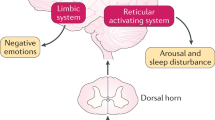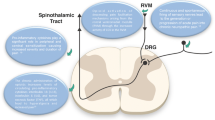Abstract
Background/Objective
Experts recommend close oversight of patients receiving opioid analgesics for chronic non-cancer pain (CNCP), especially those at increased risk of misuse. We hypothesized that physicians employ opioid risk reduction strategies more frequently in higher risk patients.
Design
Retrospective cohort using electronic medical records.
Participants
Patients on long-term opioids (≥3 monthly prescriptions in 6 months) treated for CNCP in eight primary care practices.
Methods
We examined three risk reduction strategies: (1) any urine drug test; (2) regular office visits (at least once per 6 months and within 30 days of modifying opioid treatment); and (3) restricted early refills (one or fewer opioid refills more than a week early). Risk factors for opioid misuse included: age <45 years old, drug or alcohol use disorder, tobacco use, or mental health disorder. Associations of risk factors with each outcome were assessed in non-linear mixed effects models adjusting for patient clustering within physicians, demographics and clinical factors.
Main Results
Of 1,612 patients, 8.0% had urine drug testing, 49.8% visited the office regularly, and 76.6% received restricted (one or fewer) early refills. Patient risk factors were: age <45 (29%), drug use disorder (7.6%), alcohol use disorder (4.5%), tobacco use (16.1%), and mental health disorder (48.4%). Adjusted odds ratios (AOR) of urine drug testing were significantly increased for patients with a drug use disorder (3.18; CI 1.94, 5.21) or a mental health disorder (1.73; CI 1.14, 2.65). However, the AOR for restricted early refills was significantly decreased for patients with a drug use disorder (0.56; CI 0.34, 0.92). After adjustment, no risk factor was significantly associated with regular office visits. An increasing number of risk factors was positively associated with urine drug testing (p < 0.001), but negatively associated with restricted early refills (p = 0.009).
Conclusion
Primary care physicians’ adoption of opioid risk reduction strategies is limited, even among patients at increased risk of misuse.


Similar content being viewed by others
References
Substance Abuse and Mental Health Services Administration, Office of Applied Studies. The NSDUH Report: Patterns and trends in nonmedical prescription pain reliever use: 2002 to 2005. Rockland, MD.; (April 6, 2007): Accessed on January 20, 2011. Available from: http://oas.samhsa.gov/2k7/pain/pain.pdf
Substance Abuse and Mental Health Services Administration, Office of Applied Studies. Treatment Episode Data Set (TEDS) Highlights-- 2006 National Admissions to Substance Abuse Treatment Services. OAS Series #S-40, DHHS Publication No. (SMA) 08-4313, Rockville, MD, 2007.
Centers for Disease Control and Prevention. Unintentional Poisoning Deaths-- United States, 1999-2004. MMWR Morb Mortal Wkly Rep [serial on the Internet]. 56(5): Available from: Accessed on January 20 2011. Available from: http://www.cdc.gov/mmwr/preview/mmwrhtml/mm5605a1.htm.
Paulozzi LJ, Budnitz DS, Xi Y. Increasing deaths from opioid analgesics in the United States. Pharmacoepidemiol Drug Saf. 2006;15(9):618–27.
Caudill-Slosberg MA, Schwartz LM, Woloshin S. Office visits and analgesic prescriptions for musculoskeletal pain in US: 1980 vs. 2000. Pain. 2004;109(3):514–9.
The use of opioids for the treatment of chronic pain. A consensus statement from the American Academy of Pain Medicine and the American Pain Society. Clin J Pain. 1997;13:6–8.
Federation of State Medical Boards of the United States. Model policy for the use of controlled substances for the treatment of pain. 2004.
Chou R, Fanciullo GJ, Fine PG, Adler JA, Ballantyne JC, Davies P, Donovan MI, Fishbain DA, Foley KM, Fudin J, Gilson AM, Kelter A, Mauskop A, O'Connor PG, Passik SD, Pasternak GW, Portenoy RK, Rich BA, Roberts RG, Todd KH, Miaskowski C. Clinical guidelines for the use of chronic opioid therapy in chronic noncancer pain. J Pain. 2009;10(2):113–30.
Sundwall DN, Rolfs RT, Johnson E. Utah Department of Health. Utah Clinical Guidelines of Prescribing Opioids for Treatment of Chronic Pain (2009). Salt Lake City, UT. Accessed January 20 2011. Available from: http://www.dopl.utah.gov/licensing/forms/OpioidGuidlines_summary.pdf.
Denisco RA, Chandler RK, Compton WM. Addressing the intersecting problems of opioid misuse and chronic pain treatment. Exp Clin Psychopharmacol. 2008;16(5):417–28.
Starrels JL, Becker WC, Alford DA, Williams AR, Kapoor A, Turner BJ. Opioid treatment agreements and urine drug testing in chronic pain: a systematic review. Ann Intern Med. 2010;152:712–20.
Chou R, Ballantyne JC, Fanciullo GJ, Fine PG, Miaskowski C. Research gaps on use of opioids for chronic noncancer pain: findings from a review of the evidence for an American Pain Society and American Academy of Pain Medicine clinical practice guideline. J Pain. 2009;10(2):147–59.
Gourlay DL, Heit HA, Almahrezi A. Universal precautions in pain medicine: A rational approach to the treatment of chronic pain. Pain Med. 2005;6(2):107–12.
Ives TJ, Chelminski PR, Hammett-Stabler CA, Malone RM, Perhac JS, Potisek NM, Shilliday BB, DeWalt DA, Pignone MP. Predictors of opioid misuse in patients with chronic pain: a prospective cohort study. BMC Health Serv Res. 2006;6:46.
Edlund MJ, Steffick D, Hudson T, Harris KM, Sullivan M. Risk factors for clinically recognized opioid abuse and dependence among veterans using opioids for chronic non-cancer pain. Pain. 2007;129(3):355–62.
Michna E, Jamison RN, Pham L-D, Ross EL, Janfaza D, Nedeljkovic SS, Narang S, Palombi D, Wasan AD. Urine toxicology screening among chronic pain patients on opioid therapy: frequency and predictability of abnormal findings. Clin J Pain. 2007;23(2):173–9.
Reid MC, Engles-Horton LL, Weber MB, Kerns RD, Rogers EL, O'Connor PG. Use of opioid medications for chronic noncancer pain syndromes in primary care. J Gen Intern Med. 2002;17(3):173–9.
White AG, Birnbaum HG, Schiller M, Tang J, Katz NP. Analytic models to identify patients at risk for prescription opioid abuse. Am J Manag Care. 2009;15(12):897–906.
Hall AJ, Logan JE, Toblin RL, Kaplan JA, Kraner JC, Bixler D, Crosby AE, Paulozzi LJ. Patterns of abuse among unintentional pharmaceutical overdose fatalities. JAMA. 2008;300(22):2613–20.
Morasco BJ, Dobscha SK. Prescription medication misuse and substance use disorder in VA primary care patients with chronic pain. Gen Hosp Psychiatry. 2008;30(2):93–9.
Michna E, Ross EL, Hynes WL, Nedeljkovic SS, Soumekh S, Janfaza D, Palombi D, Jamison RN. Predicting aberrant drug behavior in patients treated for chronic pain: importance of abuse history. J Pain Symptom Manage. 2004;28(3):250–8.
Wasan AD, Butler SF, Budman SH, Benoit C, Fernandez K, Jamison RN. Psychiatric history and psychologic adjustment as risk factors for aberrant drug-related behavior among patients with chronic pain. Clin J Pain. 2007;23(4):307–15.
Dunn KM, Saunders KW, Rutter CM, Banta-Green CJ, Merrill JO, Sullivan MD, Weisner CM, Silverberg MJ, Campbell CI, Psaty BM, Von Korff M. Opioid prescriptions for chronic pain and overdose: a cohort study. Ann Intern Med. 2010;152(2):85–92.
Yanni LM, Weaver MF, Johnson BA, Morgan LA, Harrington SE, Ketchum JM. Management of chronic nonmalignant pain: a needs assessment in an internal medicine resident continuity clinic. J Opioid Manag. 2008;4(4):201–11.
Akbik H, Butler SF, Budman SH, Fernandez K, Katz NP, Jamison RN. Validation and clinical application of the Screener and Opioid Assessment for Patients with Pain (SOAPP). J Pain Symptom Manage. 2006;32(3):287–93.
U.S. Census Bureau; Census 2000, Summary File 3; generated by Joanna Starrels; using American FactFinder >http://factfinder.census.gov/>; (11 June 2008)
Elixhauser A, Steiner C, Harris DR, Coffey RM. Comorbidity measures for use with administrative data. Med Care. 1998;36(1):8–27.
Turner BJ, Hollenbeak CS, Weiner M, Ten Have T, Tang SS. Effect of unrelated comorbid conditions on hypertension management. Ann Intern Med. 2008;148(8):578–86.
Agresti A. Categorical Data Analysis, 2nd Edition. Hoboken, NJ: John Wiley & Sons, Inc; 2002.
Adams NJ, Plane MB, Fleming MF, Mundt MP, Saunders LA, Stauffacher EA. Opioids and the treatment of chronic pain in a primary care sample. J Pain Symptom Manage. 2001;22(3):791–6.
Bhamb B, Brown D, Hariharan J, Anderson J, Balousek S, Fleming MF. Survey of select practice behaviors by primary care physicians on the use of opioids for chronic pain. Curr Med Res Opin. 2006;22(9):1859–65.
Boulanger A, Clark AJ, Squire P, Cui E, Horbay GLA. Chronic pain in Canada: Have we improved our management of chronic noncancer pain? Pain Res Manage. 2007;12(1):39–47.
Touchet BK, Yates WR, Coon KA. Opioid contract use is associated with physician training level and practice specialty. J Opioid Manage. 2005;1(4):195–200.
Watkins A, Wasmann S, Dodson L, Hayes M. An evaluation of the care provided to patients prescribed controlled substances for chronic nonmalignant pain at an academic family medicine center. Fam Med. 2004;36(7):487–9.
Reisfield GM, Webb FJ, Bertholf RL, Sloan PA, Wilson GR. Family physicians' proficiency in urine drug test interpretation. J Opioid Manage. 2007;3(6).
Tellioglu T. The use of urine drug testing to monitor patients receiving chronic opioid therapy for persistent pain conditions. Med Health R I. 2008;91(9):279–80. 82.
Swanson J. Urine drug screening for opioids. J Pain Palliat Care Pharmacother. 2002;16(1):111–4.
Katz NP, Sherburne S, Beach M, Rose RJ, Vielguth J, Bradley J, Fanciullo GJ. Behavioral monitoring and urine toxicology testing in patients receiving long-term opioid therapy. Anesth Analg. 2003;97(4):1097–102.
Fishbain DA, Cutler RB, Rosomoff HL, Rosomoff RS. Validity of self-reported drug use in chronic pain patients. Clin J Pain. 1999;15(3):184–91.
Atluri S, Sudarshan G. Evaluation of abnormal urine drug screens among patients with chronic non-malignant pain treated with opioids. Pain Physician. 2003;6:407–9.
Heit HA, Gourlay DL. Urine drug testing in pain medicine. J Pain Symptom Manage. 2004;27(3):260–7.
Sampson JM, Achololnu WW Jr. Reducing patient aggression and hostility in primary care with urine drug testing. South Med J. 2004;97(9):916–7.
Institute for Clinical Systems Improvement. Assessment and management of chronic pain: percentage of patients diagnosed with chronic pain who are prescribed an opioid who have an opioid agreement form and urine toxicology screen documented in the medical record (July 2008). Bloomington, MN.: Accessed on January 20 2011. Available from: http://www.qualitymeasures.ahrq.gov/summary/summary.aspx?doc_id=13005&string=urine±AND±pain.
Fleming MF, Balousek SL, Klessig CL, Mundt MP, Brown DD. Substance use disorders in a primary care sample receiving daily opioid therapy. J Pain. 2007;8(7):573–82.
Weisner CM, Campbell CI, Ray GT, Saunders K, Merrill JO, Banta-Green C, Sullivan MD, Silverberg MJ, Mertens JR, Boudreau D, Von Korff M. Trends in prescribed opioid therapy for non-cancer pain for individuals with prior substance use disorders. Pain. 2009;145(3):287–93.
Savage SR, Kirsh KL, Passik SD. Challenges in using opioids to treat pain in persons with substance use disorders. Addict Sci Clin Pract. 2008;4(2):4–25.
Compton PA, Wu SM, Schieffer B, Pham Q, Naliboff BD. Introduction of a self-report version of the Prescription Drug Use Questionnaire and relationship to medication agreement noncompliance. J Pain Symptom Manage. 2008;36(4):383–95.
Webster LR, Webster RM. Predicting aberrant behaviors in opioid-treated patients: preliminary validation of the Opioid Risk Tool. Pain Med. 2005;6(6):432–42. Nov-Dec.
Holmes CP, Gatchel RJ, Adams LL, Stowell AW, Hatten A, Noe C, Lou L. An opioid screening instrument: long-term evaluation of the utility of the Pain Medication Questionnaire. Pain Pract. 2006;6(2):74–88.
Belgrade MJ, Schamber CD, Lindgren BR. The DIRE Score: Predicting Outcomes of Opioid Prescribing for Chronic Pain. J Pain. 2006;7(9):671–81.
Fishman SM, Bandman TB, Edwards A, Borsook D. The opioid contract in the management of chronic pain. J Pain Symptom Manage. 1999;18(1):27–37.
Wiedemer NL, Harden PS, Arndt IO, Gallagher RM. The opioid renewal clinic: A primary care, managed approach to opioid therapy in chronic pain patients at risk for substance abuse. Pain Med. 2007;8(7):573–84.
Acknowledgements
This work was supported through the Program of Research Integrating Substance Use Issues into Mainstream Health Care (PRISM), funded by the Robert Wood Johnson Foundation, the National Institute on Drug Abuse (NIDA), and the Substance Abuse and Mental Health Services Administration (SAMHSA). In addition, Dr. Starrels was supported in part by the Robert Wood Johnson Foundation Clinical Scholars Program and the Office of Veterans Affairs as a VA Special Fellow. The authors thank Evelyn Crowley, MS for contributing to data management and the Montefiore Division of General Medicine Substance Abuse Research Group for feedback during preparation of the manuscript. Preliminary results of this study were presented at the 32nd annual meeting of the Society of General Internal Medicine, Miami Beach, Florida, 13-16 May 2009.
Conflict of Interest
None disclosed.
Author information
Authors and Affiliations
Corresponding author
Electronic Supplementary Material
Below is the link to the electronic supplementary material.
ESM 1
(PDF 42 kb)
Rights and permissions
About this article
Cite this article
Starrels, J.L., Becker, W.C., Weiner, M.G. et al. Low Use of Opioid Risk Reduction Strategies in Primary Care Even for High Risk Patients with Chronic Pain. J GEN INTERN MED 26, 958–964 (2011). https://doi.org/10.1007/s11606-011-1648-2
Received:
Revised:
Accepted:
Published:
Issue Date:
DOI: https://doi.org/10.1007/s11606-011-1648-2




